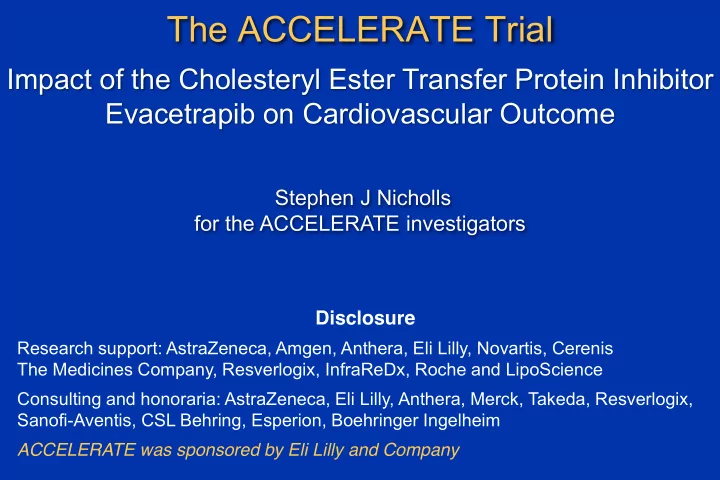

The ACCELERATE Trial Impact of the Cholesteryl Ester Transfer Protein Inhibitor Evacetrapib on Cardiovascular Outcome Stephen J Nicholls for the ACCELERATE investigators Disclosure Research support: AstraZeneca, Amgen, Anthera, Eli Lilly, Novartis, Cerenis The Medicines Company, Resverlogix, InfraReDx, Roche and LipoScience Consulting and honoraria: AstraZeneca, Eli Lilly, Anthera, Merck, Takeda, Resverlogix, Sanofi-Aventis, CSL Behring, Esperion, Boehringer Ingelheim ACCELERATE was sponsored by Eli Lilly and Company
ACCELERATE Trial Design 12,092 patients at high vascular risk, defined as: – ACS within 30-365 days – Diabetes with coronary disease – Cerebrovascular disease – Peripheral arterial disease 1:1 randomization Evacetrapib 130 mg Placebo • Event driven - Primary endpoint in 1670 patients ( CV death, MI, stroke, coronary revascularization or hosp. for unstable angina) • Minimum of 700 patients with hard events (CV death, MI or stroke), minimum of 1.5 years of follow-up per patient • 84% power to detect a 13.5% reduction in the primary endpoint
Baseline Clinical Characteristics Placebo Evacetrapib Parameter (n=6054) (n=6038) Age (years) 65 65 Males 77% 77% Caucasian 83% 82% Mean body mass index 30.2 30.3 History of hypertension 88% 87% History of diabetes 68% 68% Current smoker 16% 17% Prior myocardial infarction 67% 67% Prior PCI 72% 71% Prior CABG 29% 30%
Additional Baseline Characteristics Placebo Evacetrapib Parameter (n=6054) (n=6038) Index diagnosis Acute coronary syndrome 31% 30% Mean months from event 5.7 5.5 Cerebrovascular atherosclerotic disease 12% 12% Peripheral arterial disease 14% 14% Diabetes with coronary artery disease 64% 65% Statin use 98% 97% High intensity statin use 46% 46% Lipid levels Mean LDL-cholesterol 81 mg/dL 82 mg/dL Mean HDL-cholesterol 45 mg/dL 45 mg/dL
Percent Change in HDL-C Levels During the Trial 175 Mean HDL-C = 104 mg/dL 150 Percent Change in HDL-C (%) 125 100 Mean difference = 130% Evacetrapib 75 Placebo 50 25 Mean HDL-C = 46 mg/dL 0 -25 0 4 8 12 16 20 24 28 32 Months Following Randomization Preliminary analysis prior to formal database lock
Percent Change in LDL-C Levels During the Trial 20 Mean LDL-C = 84 mg/dL Percent Change in LDL-C (%) 10 0 Evacetrapib Mean difference 37% -10 Placebo -20 -30 Mean LDL-C = 55 mg/dL -40 -50 0 4 8 12 16 20 24 28 32 Months Following Randomization Preliminary analysis prior to formal database lock
Cumulative Incidence of Primary Efficacy Endpoint Evacetrapib, 774 events (12.8%) Cumulative Event Rate (%) Placebo, 768 events (12.7%) HR = 1.01 95% CI, 0.91-1.12 P=0.85 Months Following Randomization Preliminary analysis prior to formal database lock
Secondary Efficacy Endpoints Placebo Evacetrapib HR P (n=6054) (n=6038) (95% CI) Value 0.98 CV death, MI, stroke 444 (7.3) 434 (7.2) 0.73 (0.86,1.12) 0.86 CV death 163 (2.7) 140 (2.3) 0.18 (0.68,1.08) 1.00 MI 255 (4.2) 256 (4.2) 0.97 (0.84,1.19) 0.97 Stroke 95 (1.6) 92 (1.5) 0.82 (0.73,1.29) Hospitalization for unstable 1.08 143 (2.4) 155 (2.6) 0.48 angina (0.86,1.36) 1.01 Coronary revascularization 482 (8.0%) 485 (8.0%) 0.92 (0.89, 1.14) 0.84 All cause mortality 269 (4.1) 227 (3.8) 0.06 (0.71-1.01) Preliminary analysis prior to formal database lock
Adverse Clinical and Biochemical Events Parameter Placebo Evacetrapib P Value Discontinuation due to adverse 8.7% 8.6% 0.86 events ALT >3x ULN 0.7% 0.6% 0.31 Bilirubin >2x ULN 0.3% 0.1% 0.06 CK >3x ULN 3.1 % 2.3% <0.01 Median change in hsCRP -8% +4.6% <0.01 New onset diabetes 183 (3.0%) 149 (2.5%) 0.06 Investigator-reported hypertension 609 (10.1%) 686 (11.4%) <0.05 Ventricular tachycardia 45 (0.7%) 28 (0.5%) <0.05 Preliminary analysis prior to formal database lock
Conclusions • Despite a 37% decrease in LDL-C and a 130% increase in HDL-C, evacetrapib did not reduce the primary composite endpoint of major adverse CV events. • A borderline significant (p=0.06) reduction in all-cause mortality was observed in the evacetrapib group. • The failure of decreases in LDL-C to result in an overall morbidity-mortality benefit emphasizes the limitations of surrogate endpoints. • The findings continue to challenge the hope that CETP inhibition might successfully address residual CV risk.
ACCELERATE Data Sharing Initiative The study sponsor (Eli Lilly) and the academic leadership are pleased to announce that the trial database will be made available to independent investigators • Proposals will be accepted beginning 12 months after the publication of the primary ACCELERATE manuscript • Review of Proposals and Governance will be coordinated by the academic research organization at the Cleveland Clinic that led the trial (C5Research). • Further information on submitting research proposals for review will be made available in the future at: http://c5research.clevelandclinic.org/Home.aspx
Recommend
More recommend